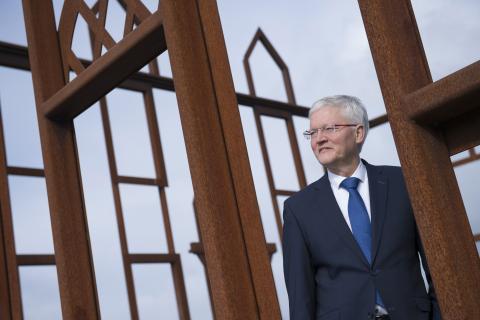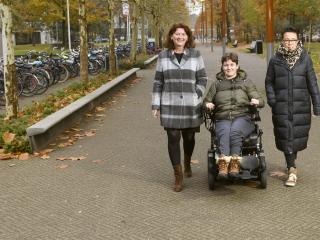Is the Heart of Brabant still beating?
Nine Brabant municipalities collaborate in the Heart of Brabant Region. Tilburg University has recently investigated whether the way in which they are currently doing so, the governance, is still working effectively. Tilburg University Professor Martijn Groenleer and regional chair Theo Weterings discuss the tension between local autonomy and the importance of regional collaboration.
Good neighbors make agreements, help one another, and collaborate. The same goes for municipalities. In Brabant, Dongen, Gilze en Rijen, Goirle, Heusden, Hilvarenbeek, Loon op Zand, Oisterwijk, Tilburg, and Waalwijk have been members of the Heart of Brabant Region for many years now. They have made agreements on collaboration in such fields as youth care, spatial planning and mobility, and the stimulation of economic development.

If you want to intensify collaboration and spend more money together, this also raises questions about democratic legitimacy
Regional Chair Theo Weterings
In a joint meeting of the city councils on the strategic multiannual program, council members wanted to extend the collaboration to more fields, says Theo Weterings, the Mayor of Tilburg and chair of the Heart of Brabant Region (and Tilburg University alumnus). “The city councils expressed the wish to collaborate in even more areas. However, that proved to be impossible because joint resources are lacking. If you want to intensify collaboration and want to spend more money together, this also raises questions about democratic legitimacy. For this reason, the joint meeting passed a motion requesting a study on the possibilities open to them. We wanted to know how we can further develop the collaboration and whether it should be done in a different form.”
Tomorrow’s generation
The Heart of Brabant Region commissioned Tilburg University to conduct the study. The university teamed up with KWINK groep research agency, with Martijn Groenleer acting as the study director. According to the Regional Law Professor, municipalities need to collaborate in increasingly many areas: “One example is the energy transition. In that context, we have energy regions and the question arises: what is the best way to organize them? You do not only want to involve administrators and civil servants but also citizens and businesses.”
The Heart of Brabant Region did not need to think long who they would ask to carry out the study. Weterings: “When we discussed that question in the joint meeting, it was clear we could find the research capacity close to home. We all know the education and research institutions in our region very well. Many people had their education here. And we find Tilburg University a very pleasant partner. If you have so much expertise on your doorstep, why not benefit from it?”
The city councils did indicate that they felt it was important for tomorrow's generation to be involved, says Weterings. According to Groenleer, this was done in various ways, among other things, through talks in which young council members participated. The university also organized governance clinics. For instance, teams of students looked into the role of city councils and citizens in the regional energy strategy. The results were used in the study.
We look at the regional ecosystem not as outsiders but as an active part of it
Professor of Regional Law and Governance Martijn Groenleer

Groenleer thinks that there are benefits if the researchers are local. What is more, it creates a certain responsibility. “We look at the regional ecosystem not as outsiders but as an active part of it.” The important thing, of course, is to maintain the necessary scientific distance. And to ensure that the study has value beyond Brabant. One of the ways in which we did so was comparing the Heart of Brabant Region with other regional partnerships. In Weterings’ opinion, lessons learnt in other regions are also valuable for Heart of Brabant. “After all, the goal is to gauge what kind of partnership is the best fit for the future.”
Merwede Parliament
The current collaboration in the Heart of Brabant Region is based on a council regulation. The governing board consists of the mayors, while aldermen manage the portfolios. Officers of the various municipalities execute the policies, supported by a compact regional office. The city councils can convene a joint meeting of city councils, which, by the way, cannot pass binding motions.
This collaboration is quite intensive, but does not go as far as in the Drechtsteden region, in which seven municipalities bordering the river Merwede collaborate. They even have a joint council, jokingly referred to as the ‘Merwede Parliament’. However, they have since changed their minds on that joint council, Groenleer says. “That separate administrative tier, the Drecht Council, is going to be disbanded in 2022.” This is owing, among other things, to tensions due to differences among the various municipalities. “One city is much larger that another and is struggling with different issues, so they have different interests. These had better be acknowledged. In Drechtsteden, this happened less and less as time went on. It was also insufficiently clear why collaboration was necessary, what the added value was, and whether the region delivered what it had promised.”
According to Weterings, there is always some tension between local autonomy and the importance of inter-city collaboration. “That tension can be reduced by engaging all city councils in the decision-making process. In addition, you have to make it clear how collaboration benefits the public.”
An example of the collaboration in the Heart of Brabant Regional Energy and Climate Strategy (in Dutch) ->
Scenarios
The preliminary findings of the study were shared with a large group of council members and other interested parties. In an online discussion meeting, they were able to respond to comments by interviewees. These responses were included in the study. Groenleer: “People are generally positive as well as critical but also realistic. They realize that regional collaboration is about issues that are difficult to solve locally and that involve many different interests.”
Weterings was also present at the discussion meeting and had a good feeling about it. Of course, council members continue to critically monitor local autonomy. But the overall view is: let’s do things together as much as possible.” The study presents leads based on scenarios about the organization of the collaboration in the future.
Whether the Heart of Brabant Region will switch to a new form of collaboration is still completely open, according to Weterings. As the regional chair, he needs to remain impartial: “The city councils are going to discuss the collaboration based in this report. We want to start and finish that discussion in 2021, before the next municipal elections in 2022. Then we shall know whether a new form of cooperation between the neighboring municipalities will be opted for.”
Summary of research results Hart van Brabant governance
There is insufficient balance in the collaboration in the Hart van Brabant region. This is argued in the research report, entitled Balanceren, verbinden en schakelen, on the governance in this collaboration region. Ambitions are high, but the resources and capacity available are limited. In addition, the legitimacy of regional decisions and the execution are points of concern, and mutual trust could be improved. The question is whether and, if so, how the region should change the collaboration. To this end, the report outlines seven possible scenarios.
After interviews with all parties concerned, the researchers recommend a combined scenario. The interviews suggest that some of the parties think that the Hart van Brabant region should become active in more fields. Other parties argue the region should choose clear priorities, even if this means that municipalities will be undertaking fewer things together. In addition, it is clear that many parties want to continue on the path already chosen.
According to the researchers, all of these views can be met by a combined scenario, in which the municipalities work together intensively on a selected number of issues, a core agenda. And collaborate, in different constellations, based on an ‘options agenda’, on a number of other regional issues. “This could offer both flexibility and space to maneuver, as well as clarity, transparency, and unity.” The researchers recommend to first decide in what themes the municipalities really want to make a difference.
Another recommendation is to increase the support base for regional collaboration, for instance, reinforcing the role and position of the sounding board group, improving the feedback by aldermen in the local councils, and appointing rapporteurs from the councils. In addition, the researchers recommend that the Hart van Brabant region increase the impact of the collaboration. It can do so by expanding the project office (programmabureau), bolstering the role of the aldermen on a regional level, or expanding the local civil servant capacity.
Date of publication: 9 March 2021



